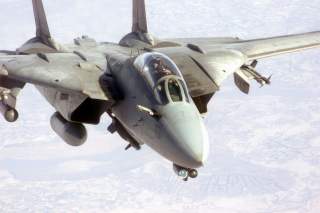The Forgotten Backstory to “Top Gun” and the F-14
A great story.
In addition, Topgun Days provides also some never-before told details about the famous movie Top Gun.
An old U.S. Navy commercial claimed, “Navy: it’s not just a job, it’s an adventure.”
Dave “Bio” Baranek was one who personally turned the slogan into reality.
Bio in fact spent twenty years in the United States Navy, with assignments to F-14 Tomcat squadrons and the elite Topgun training program being some highlights of his career.
In 2010 Bio decided to make an outstanding gift to the aviation geeks worldwide when, publishing his first book Topgun Days: Dogfighting, Cheating Death and Hollywood Glory as One of America’s Best Fighter Jocks, he revealed the adrenaline experienced by U.S. Naval Aviators and Naval Flight Officers (NFOs) during their day to day life in a Fleet Squadron.
As described in the chapter “Rocket Rider,” on Dec. 19, 1981 Bio experienced one of the most exciting moments of his 3 ½ year assignment to Fighter Squadron (VF) 24 Fighting Renegades. On that day he and Commander Bill Switzer (then VF-24 Commanding Officer, CO) were scheduled to fly a series of 2v2 radar intercepts, F-14 Tomcats against A-7 Corsairs. Baranek and Switzer completed their mission and at 5:15 PM were ready to land aboard their aircraft carrier USS Constellation (CV-64), sailing in the Indian Ocean.
But just after they slammed onto the flight deck, Bio realized that something was wrong. As Baranek recalls “I should have been thrown forward into my shoulder straps by the sudden deceleration of the trap, but instead I was still sitting upright. […] We rolled along the deck. There was some resistance slowing us down, but nowhere near enough to bring Renegade 205 to a stop. In a normal trap, the arresting wire plays out like a fishing line under tension, and the rollout of several hundred feet of cable takes about two seconds. […] Then there was one last feeble tug, but we continued rolling toward the end of the landing area. We were traveling about fifty knots – too fast to stop, too slow to fly. Skipper Switzer called, ‘Eject! Eject!’ His voice had taken on a new urgency, almost impatience – What are you waiting for? His hand was on the stick, still trying to fly, so it was my job to pull the handle that would eject both of us.”
Bio reacted on Switzer’s first syllable, yanking the yellow-and-black striped ejection handle. Once Baranek pulled the handle, everything that followed was automatic as he explains in detail. “When the ejection sequence control mechanism determined the canopy had cleared the aircraft, the rocket in my seat fired. I instantaneously experienced an acceleration force of about 20 g – outside the recommended operating range of the human brain-and blacked out for a few seconds.”
Bio and Switzer were recovered by one of the SH-3 Sea King rescue helicopters of the ship and it was later determined that the mishap was caused by one of the four cables (the one engaged by Switzer and Bio’s Tomcat) was not set to the correct F-14 weight.
For this reason, as you can see in the following video (which is the footage of the actual incident) since the arresting gear mechanism was completely overwhelmed, the cable snapped and the Tomcat (Renegade 205, F-14A BuNo 159623) went over the side. And in Topgun Days we get an instant-by-instant description by one who personally experienced it.
In addition, Topgun Days provides also some never-before told details about the famous movie Top Gun.
For instance, do you remember one of the most famous scenes of the motion picture, where Maverick and Goose’s F-14 flies inverted above the black two-seat F-5F (AKA MiG-28)? Of course, for safety reasons there wasn’t any aircraft flying inverted one above the other, and that iconic scene was obtained thanks to one of the few special effects in the film.
In fact as Bio explains, many of the movie flying scenes were filmed from the specially equipped Learjet flown by the former fighter pilot Clay Lacy. “I was to fly (aboard the F-5F) with Rat (actually Bob “Rat” Willard was the Topgun squadron’s primary coordinator for the movie) who briefed the flight. […] We would have two F-14s and four F-5s available, but the first scene would involve only the two-seat F-5F flying in formation alongside the Learjet. On a call from the Lear, both Rat and I would look up, acting as startled as we could. Although there would be nothing above us, Rat explained how this shot would be used for the scene where Maverick’s Tomcat is inverted above the MiG-28. The F-14 would be added later in one of the few special effects in the film.”
So, once the aircraft took off Rat made a radio call to detach the three F-5Es to join the Tomcats, while he and Bio got into a tight formation on the Lear’s right side where Baranek saw “the glass window that made up a large panel on this side of the fuselage. One high-quality camera sat behind the glass, others were mounted on the top and belly of the Lear.”
Then, as Bio explains, a voice came from the Learjet. “ ‘A little forward. That’s good. When I count to three, both of you look up as quickly as you can. Remember, you’re startled. One, two, three!’ I looked up. It was hard to act startled in all my flight gear and oxygen mask. No feedback, just a small voice, ‘Ok let’s do it again. Remember, you are startled that there is an F-14 above you. One, two three!’ They didn’t teach us this in Pensacola.”
Topgun Days also has more than 50 photos that will take you to the danger zone!
This article by Dario Leone originally appeared on The Aviation Geek Club in 2017.
Image: Wikimedia.

